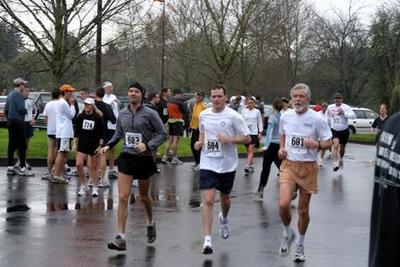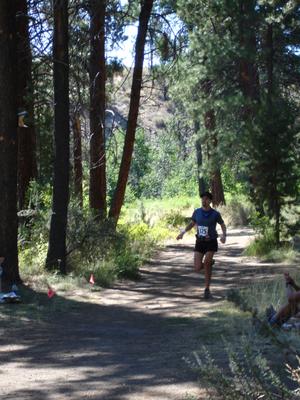Super-star NCAA runner Dylan Olchin is cleaning house in the Nike Summit Trail Running Series. Don't feel bad if you finished behind him - his wicked fast 14:14 5k conference record in 2003 for Colorado State still stands.
The Nike Summit Trail Running Series is a great series put on by the Town of Breckenridge. One of the coolest features of their races is that they encourage young runners by allowing free registration for any runner younger than 18 years of age. - SD
Olchin finishes trail series unbeaten, unchallenged
August 24, 2005
Yes, even the unbeatables get nervous.
Dylan Olchin, as dominant as athletes come in this area, had won all five Nike Summit Trail Running Series long-course races going into Wednesday night's series finale. Yet there he was in his trademark white tank top, worrying away the moments before the race.

About 55 minutes and 10 grueling miles later, he proved the nerves were simply instinct, nothing more, as he won his sixth race with ease and completed the year undefeated and untested.
While he may be known to many as the skinny guy who just wins, baby, Olchin provokes more pointed reverence among those who finish closest to him.
"He's in a different league," said Steve Marshall, a perennial top-three finisher in the men's long-course races. "I can't think of anybody who's faster than him on trails, honestly. He should be running in bigger races. This is too easy for him. ... He could probably come out in jeans and boots and bury us all. He should be doing the big races and making money on it. He needs to reconsider his day job."
Paul Brett, last year's series champ and one of the strongest runners in the county, concurred. "He's not sponsored," Brett said of Olchin, an accountant for Grand Timber Lodge. "He's just walking around doing this for fun. If any one of those people, like Nike representatives, saw him, they should be all over him, because he dominates everybody."
Olchin virtually sprinted to victory, as usual, finishing the uphill-heavy course in 54 minutes, 56 seconds. Brett took second (58:47) after passing Marshall (third place, 1:00:36) about 20 minutes into the race, which began and ended at Carter Park.
Carlos Martinez (1:06:46) took fourth, while Duke Barlow (1:08:51) rounded out the top five.
In the women's long course race, Eagle's Katie Mazzia (1:11:54) made the most of her trip over Vail Pass by outlasting Jaime Falcon (1:12:23), a two-time winner in this summer's series. Mazzia, who didn't realize she'd won until long after the race had finished, passed Falcon with about 15 minutes to go when Falcon lost her focus for just long enough.
"I think I was kind of unconsciously slowing down a little bit," Falcon said. "Then I was like, OK, get going again, get going again! And I did more at the end, but (it was too late)."
Monica Wilson (1:14:51) crossed the line for third, while Kate Lapides (1:16:16) and Catherine Burns (1:19:41) completed the top five.
Making it two Eagle County winners in one evening, Lynda Andros remained undefeated in women's short-course races this summer with her fifth win in five tries (she missed a race earlier in the season). She breezed to victory in 38:05, and was followed by youngster Alison Rowe (42:58), consistent top-five finisher Julie Thebeau (43:27), Shannon Marshall (43:55) and Marcy Spaulding (44:58).
Men's short-course winner Patrick Neel built a comfortable lead on the approximately 2.5-mile ascent, then used a simple but effective strategy over the final 2.5-mile downhill stretch to win his second straight race in the series.
"I ran like I stole something," he quipped. Asked what he stole, Neel's cousin, Kyle Ahern (Wednesday's third-place finisher), chimed in, "Some little filly's heart."
Keystone's Charles Nowacki (35:01) was the runner-up thanks to one of his best efforts of the series, followed by Ahern (35:56), Kent Lange (36:55) and Jim Levi (39:49).
Although the short-course racers by no means got off easy (they climbed about 900 feet), they didn't have to deal with the aptly named "Nightmare on Baldy," a draining ascent that sent the series out in style.
"It was probably one of the hardest hills we've done all summer," Olchin said. "I was ready to walk it, but then I saw some people at the top and just said, I can't walk in front of people."
Devon O'Neil can be contacted at (970) 668-3998, ext. 231, or at doneil@summitdaily.com.
STRS Finale Top 3's
Carter Park, Breckenridge
Men's Long Course (10 miles)
1. Dylan Olchin - 54:56
2. Paul Brett - 58:47
3. Steve Marshall - 1:00:36
Women's Long Course
1. Katie Mazzia - 1:11:54
2. Jaime Falcon - 1:12:23
3. Monica Wilson - 1:14:51
Men's Short Course (5 miles)
1. Patrick Neel - 33:12
2. Charles Nowacki - 35:01
3. Kyle Ahern - 35:56
Women's Short Course
1. Lynda Andros - 38:05
2. Alison Rowe - 42:58
3. Julie Thebeau - 43:27
(Copyright Summit Daily News, 2005, All Rights Reserved)








